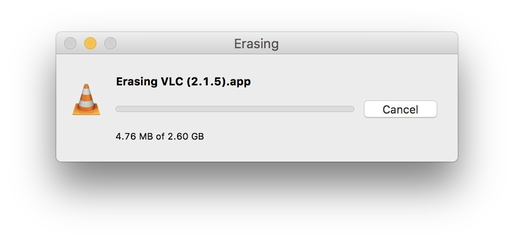

 When you normally delete files on the Mac, the operating system is only forgetting where those particular files are placed, while the data still physically remains on the drive. Beginning with Mac OS X 10.3, Apple enhanced its security by introducing the Secure Empty Trash feature, which follows the U.S. DoD pattern of overwriting data seven times. This feature was then later removed in OS X 10.11 El Capitan.
When you normally delete files on the Mac, the operating system is only forgetting where those particular files are placed, while the data still physically remains on the drive. Beginning with Mac OS X 10.3, Apple enhanced its security by introducing the Secure Empty Trash feature, which follows the U.S. DoD pattern of overwriting data seven times. This feature was then later removed in OS X 10.11 El Capitan.
Permanent Eraser provides additional wiping methods such as the 3-pass DoE or 35-pass Gutmann algorithms. This utility overwrites your data multiple times, scrambles the original file name, and truncates the file size to nothing before Permanent Eraser finally unlinks it from the system. Once your data has been erased, it can no longer be read through traditional means.
 Permanent Eraser fills in what the Finder forgot! Simply drag a CD-RW or DVD-RW onto Permanent Eraser to erase the disc's contents.
Permanent Eraser fills in what the Finder forgot! Simply drag a CD-RW or DVD-RW onto Permanent Eraser to erase the disc's contents.
 Mac OS 10.4+ users get to make use of the bonus Automator Actions and Finder plug-in built to work with Permanent Eraser. Right-click on items you want to destroy and select Services → Erase, or make use of the Erase Trash, Erase Selected Items, or Erase Free Space Automator Actions.
Mac OS 10.4+ users get to make use of the bonus Automator Actions and Finder plug-in built to work with Permanent Eraser. Right-click on items you want to destroy and select Services → Erase, or make use of the Erase Trash, Erase Selected Items, or Erase Free Space Automator Actions.
 Don't want to take up more space in your already cluttered Dock? Instead, drag Permanent Eraser into your Finder's toolbar or sidebar for easy access to wipe away the files you no longer need.
Click the icon to empty your Trash, or drag and drop files to erase them.
Don't want to take up more space in your already cluttered Dock? Instead, drag Permanent Eraser into your Finder's toolbar or sidebar for easy access to wipe away the files you no longer need.
Click the icon to empty your Trash, or drag and drop files to erase them.
 Permanent Eraser has been translated for English, German, French, Italian, Dutch, Swedish, Traditional Chinese, and Welsh.
Permanent Eraser has been translated for English, German, French, Italian, Dutch, Swedish, Traditional Chinese, and Welsh.
 Not only has the progress meter's accuracy greatly increased over earlier versions, but it is also displayed from the Dock's icon.
Not only has the progress meter's accuracy greatly increased over earlier versions, but it is also displayed from the Dock's icon.
Due to increased security measures in newer versions of macOS, additional steps are required to enable the full functionality of Permanent Eraser. If you are noticing issues where Permanent Eraser is not working fully in macOS Catalina or Mojave, please refer to the documents Enabling Full Disk Access for Permanent Eraser in macOS Catalina and Enabling the Erase Service for Permanent Eraser in macOS Mojave.